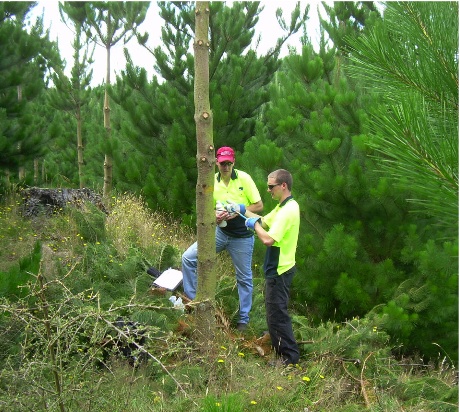PESTS AND DISEASES OF FORESTRY IN NEW ZEALAND
Nectria fuckeliana in pruned an unpruned trees
Scion is the leading provider of forest-related knowledge in New Zealand
Formerly known as the Forest Research Institute, Scion has been a leader in research relating to forest health for over 50 years. The Rotorua-based Crown Research Institute continues to provide science that will protect all forests from damage caused by insect pests, pathogens and weeds. The information presented below arises from these research activities.
From Forest Health News No. 175, July 2007.
Last year we reported an unexpected finding that the DNA of Nectria fuckeliana was detected in both pruned and unpruned trees (see FH News 165 August 2006, and FH News 167 October 2006). Statistical analysis showed that there was no significant difference between pruned and unpruned trees in the presence of N. fuckeliana.
In February 2007, we took one wood core from every tree that was sampled in 2006, comprising 90 pruned trees and 90 unpruned trees. The cores were taken directly above a branch stub on pruned trees or, in the unpruned trees, as close to the whorl as possible. All 180 trees were assessed for the presence of flutes. Back in the laboratory, samples were taken from the wood cores and tested using a DNA-based identification method and the traditional technique of culturing on agar plates.

Using molecular identification N. fuckeliana was detected from 39 of the 180 cores, and from 11 cores by culturing. The higher number of positive results obtained using the DNA technique compared to culturing may have been due to the fact that only a small sub-sample of the core was taken for culturing as opposed to a large sub-sample for the DNA analysis. It is therefore possible that, if the fungus was not evenly distributed within the core, it was not detected in this small sample for culturing.
The fungus was identified in pruned and unpruned trees using both techniques. Using the DNA technique, Nectria fuckeliana was found in 19% of the pruned trees and 24% of the unpruned trees, and Chi square analysis indicated that there was no significant relationship between the presence of N. fuckeliana and whether the tree was pruned or unpruned. This confirms findings in 2006.
Analysis also showed that there was a statistically significant relationship between the presence of fluting and the presence of N. fuckeliana in the tree. Trees with N. fuckeliana were more likely to be fluted, with the fungus detected in 30% of the trees with flutes and in 13% of the trees without flutes. We are cautious about the practical significance of this finding as most of the flutes were minor and it was uncertain whether they were the result of infection or merely natural depressions associated with branch whorls. In early 2009, we will destructively sample selected trees and map the presence of N. fuckeliana in the tree in order to deduce the infection route and determine the relationship between presence of the fungus and fluting. A report on this work will be
posted on the Forest Biosecurity Research Council (FBRC) website soon (www.fbrc.org.nz).
Matt Power and Tod Ramsfield
This information is intended for general interest only. It is not intended to be a substitute for specific specialist advice on any matter and should not be relied on for that purpose. Scion will not be liable for any direct, indirect, incidental, special, consequential or exemplary damages, loss of profits, or any other intangible losses that result from using the information provided on this site.
(Scion is the trading name of the New Zealand Forest Research Institute Limited.)

 Farm Forestry New Zealand
Farm Forestry New Zealand

